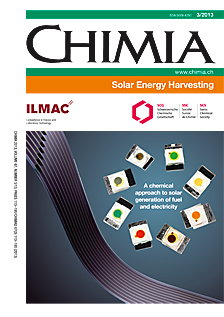Dye-sensitized Solar Cells Employing a SnO2-TiO2 Core-shell Structure Made by Atomic Layer Deposition
DOI:
https://doi.org/10.2533/chimia.2013.142Keywords:
Core-shell, Dye-sensitized solar cell, Electron lifetime, Photo-capacitor, Spiro-ometadAbstract
This paper describes the synthesis and characterization of core-shell structures, based on SnO2 and TiO2, for use in dye-sensitized solar cells (DSC). Atomic layer deposition is employed to control and vary the thickness of the TiO2 shell. Increasing the TiO2 shell thickness to 2 nm improved the device performance of liquid electrolyte-based DSC from 0.7% to 3.5%. The increase in efficiency originates from a higher open-circuit potential and a higher short-circuit current, as well as from an improvement in the electron lifetime. SnO2-TiO2 core-shell DSC devices retain their photovoltage in darkness for longer than 500 seconds, demonstrating that the electrons are contained in the core material. Finally core-shell structures were used for solid-state DSC applications using the hole transporting material 2,2',7,7',-tetrakis(N, N-di-p-methoxyphenyl-amine)-9,9',-spirofluorene. Similar improvements in device performance were obtained for solid-state DSC devices.Downloads
Published
2013-03-27
Issue
Section
Scientific Articles
License
Copyright (c) 2013 Swiss Chemical Society

This work is licensed under a Creative Commons Attribution-NonCommercial 4.0 International License.
How to Cite
[1]
M. Karlsson, I. Jõgi, S. K. Eriksson, H. Rensmo, M. Boman, G. Boschloo, A. Hagfeldt, Chimia 2013, 67, 142, DOI: 10.2533/chimia.2013.142.







